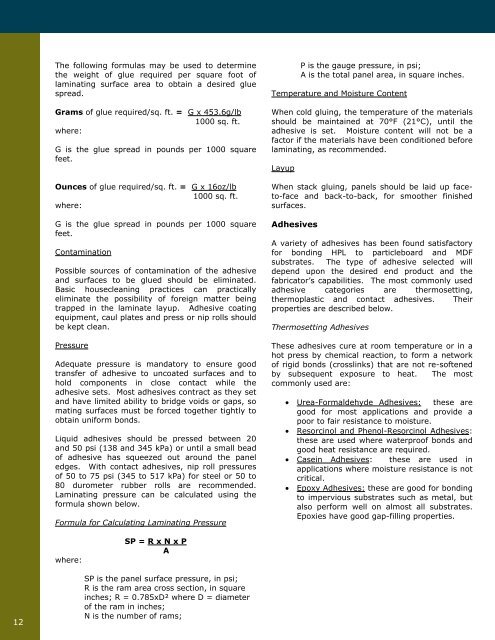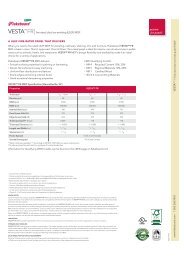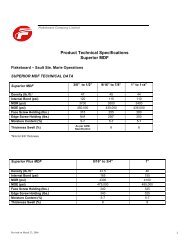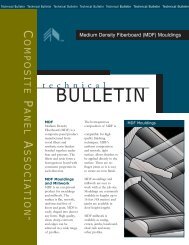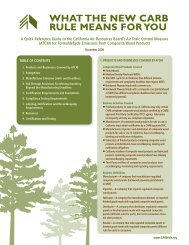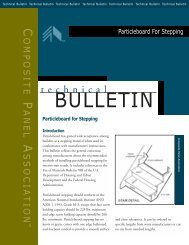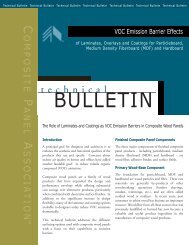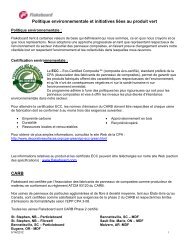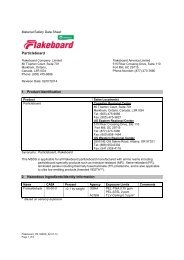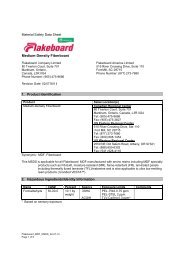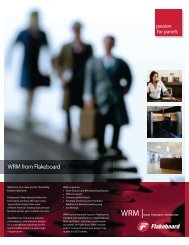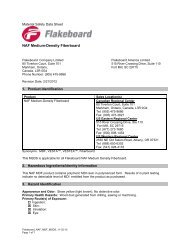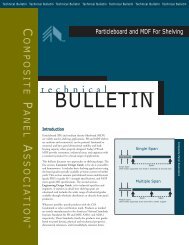Laminating Composite Panels - Flakeboard
Laminating Composite Panels - Flakeboard
Laminating Composite Panels - Flakeboard
You also want an ePaper? Increase the reach of your titles
YUMPU automatically turns print PDFs into web optimized ePapers that Google loves.
The following formulas may be used to determine<br />
the weight of glue required per square foot of<br />
laminating surface area to obtain a desired glue<br />
spread.<br />
Grams of glue required/sq. ft. = G x 453.6g/lb<br />
1000 sq. ft.<br />
where:<br />
G is the glue spread in pounds per 1000 square<br />
feet.<br />
Ounces of glue required/sq. ft. = G x 16oz/lb<br />
1000 sq. ft.<br />
where:<br />
G is the glue spread in pounds per 1000 square<br />
feet.<br />
Contamination<br />
Possible sources of contamination of the adhesive<br />
and surfaces to be glued should be eliminated.<br />
Basic housecleaning practices can practically<br />
eliminate the possibility of foreign matter being<br />
trapped in the laminate layup. Adhesive coating<br />
equipment, caul plates and press or nip rolls should<br />
be kept clean.<br />
Pressure<br />
Adequate pressure is mandatory to ensure good<br />
transfer of adhesive to uncoated surfaces and to<br />
hold components in close contact while the<br />
adhesive sets. Most adhesives contract as they set<br />
and have limited ability to bridge voids or gaps, so<br />
mating surfaces must be forced together tightly to<br />
obtain uniform bonds.<br />
Liquid adhesives should be pressed between 20<br />
and 50 psi (138 and 345 kPa) or until a small bead<br />
of adhesive has squeezed out around the panel<br />
edges. With contact adhesives, nip roll pressures<br />
of 50 to 75 psi (345 to 517 kPa) for steel or 50 to<br />
80 durometer rubber rolls are recommended.<br />
<strong>Laminating</strong> pressure can be calculated using the<br />
formula shown below.<br />
Formula for Calculating <strong>Laminating</strong> Pressure<br />
P is the gauge pressure, in psi;<br />
A is the total panel area, in square inches.<br />
Temperature and Moisture Content<br />
When cold gluing, the temperature of the materials<br />
should be maintained at 70°F (21°C), until the<br />
adhesive is set. Moisture content will not be a<br />
factor if the materials have been conditioned before<br />
laminating, as recommended.<br />
Layup<br />
When stack gluing, panels should be laid up faceto-face<br />
and back-to-back, for smoother finished<br />
surfaces.<br />
Adhesives<br />
A variety of adhesives has been found satisfactory<br />
for bonding HPL to particleboard and MDF<br />
substrates. The type of adhesive selected will<br />
depend upon the desired end product and the<br />
fabricator’s capabilities. The most commonly used<br />
adhesive categories are thermosetting,<br />
thermoplastic and contact adhesives. Their<br />
properties are described below.<br />
Thermosetting Adhesives<br />
These adhesives cure at room temperature or in a<br />
hot press by chemical reaction, to form a network<br />
of rigid bonds (crosslinks) that are not re-softened<br />
by subsequent exposure to heat. The most<br />
commonly used are:<br />
Urea-Formaldehyde Adhesives: these are<br />
good for most applications and provide a<br />
poor to fair resistance to moisture.<br />
Resorcinol and Phenol-Resorcinol Adhesives:<br />
these are used where waterproof bonds and<br />
good heat resistance are required.<br />
Casein Adhesives: these are used in<br />
applications where moisture resistance is not<br />
critical.<br />
Epoxy Adhesives: these are good for bonding<br />
to impervious substrates such as metal, but<br />
also perform well on almost all substrates.<br />
Epoxies have good gap-filling properties.<br />
where:<br />
SP = R x N x P<br />
A<br />
12<br />
SP is the panel surface pressure, in psi;<br />
R is the ram area cross section, in square<br />
inches; R = 0.785xD² where D = diameter<br />
of the ram in inches;<br />
N is the number of rams;


